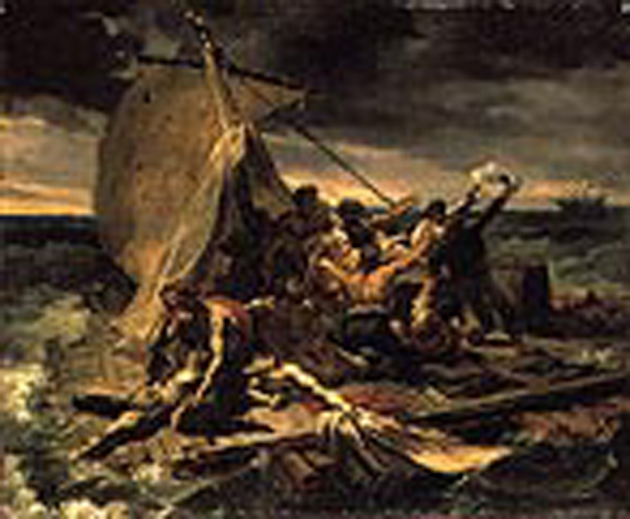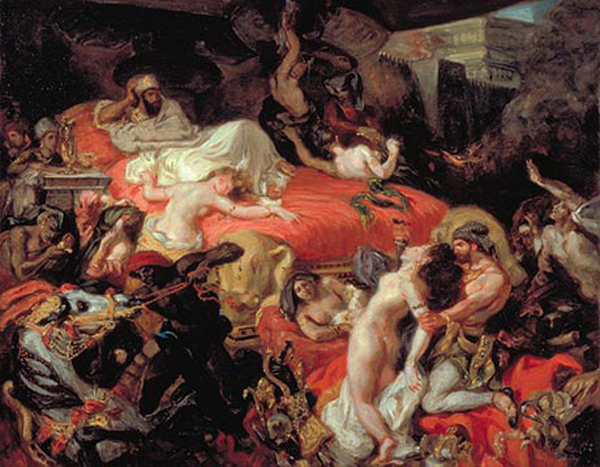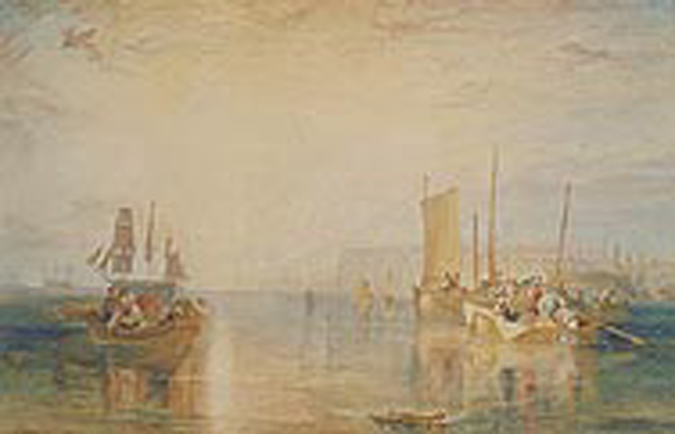Crossing the Channel with Three Artists and a Critic
"Crossing the Channel," at the MIA through September 7, is a big show of high-Romantic painting. Michael Fallon walks through the show with artists Clea Felien, Jim Denomie, and Celeste Nelms as they discuss how the show relates to their own work.



“Crossing the Channel,” the current exhibition in the Target Gallery at the Minneapolis Institute of Arts (through September 7), is a gem of a show of that examines the influence of nineteenth-century British artists and writers on the French artists of the time. Unfortunately, this show has not received the attention and acclaim in curator Patrick Noon’s own backyard as it did when it showed earlier this year at the Tate London. And while it’s likely to create some new buzz when it goes to the Metropolitan Museum later this year, local ambivalence is somewhat of a tragedy–as this is the best show I’ve seen all year.
I recently gathered with three local artists–painter Clea Felien, photographer Celeste Nelms, and painter Jim Denomie–to talk about some of the many issues that the show raises, and compare the practice and business of nineteenth-century artists to that of artists today. An edited transcript follows.
Michael Fallon: First off, please say something about yourself and about your artistic practice.
Clea Felien: I went to MCAD and the Atelier. I now paint with my left hand–my work, complex psychological portraits–and with my right hand is how I make a living. I teach technical painting and I do technical portraits.
Jim Denomie: I graduated from the U of M in 1995, with a BFA. I’m primarily a painter but getting into monoprints and other printing techniques and photography. My subject matter is creative storytelling of social, political, and personal issues.
Celeste Nelms: I work in black-and-white photography and self-portraiture, and my subject matter is discarded objects from people.
Michael: Thank you. We are standing in front of the “Raft of the Medusa,” or at least a copy of it–painted by Pierre-Desire Guillemet and Etienne-Antoine-Eugene Ronjat in 1859-60 after the original by Gericault from 1819 [the original is too fragile to travel]. It’s a massive painting–measuring 23 1/2 feet wide by 16 feet tall–and powerful. My question is, do you think that art today can ever again approach the monumental qualities of a painting like this? Or perhaps you can think of art today that is as powerful?
Clea: I think a lot of art today is very strong and has an impact that is both up-front and lasting. This is true in all mediums. I’m thinking of Kiki Smith and Leon Golub in particular. But there are lots of artists.
Jim: This painting is just “wow.” It’s very overpowering. I don’t know that I’ve seen many works that come close to this scale and magnitude, but I have seen other works that have a scale, of maybe 8-10 feet by 12, that is very impressive. I was in Dallas last year and I walked through gallery and happened to see this fabulous show by a painter I’ve never heard of before, John Alexander. The scale and the action in his painting was just, I don’t know–I just enjoyed it so much. I spent two hours walking around the gallery. And I know there are other artists that I’ve seen that have such a strong impact.
Celeste: Yes, there are a lot of incredible artists right now, and it’s hard for us to imagine that what’s going on right now will someday be history. I really love thinking about that, because we’re human, we’re always expressing emotions, painting things, events, about our lives and the world. And also, I have seen work in the present that draws me in like this painting. I know this painting is so incredibly overwhelming because of its size–it’s larger than life. But I’ve also seen very small paintings that are powerful too.
Michael: Part of the impact of this work was political and social. It was an indictment of the government of the time. And the government actually hid the original painting away for a number of years. They took it off the stretcher bars and rolled it up and put it in the basement. Do you think that art still has the ability to have a social impact?
Clea: Oh yeah, look at what Jesse Helms did. Absolutely. They shut down museums because of Mapplethorpe’s work.
Jim: And the other artist, Andres Serrano.
Clea: Right, “Piss Christ.” You know, Sister Wendy [the art historian, star of the PBS series and books on art appreciation] said she loves Serrano’s work. “Piss Christ,” she said, showed how people treated the Catholic Church and Christ. She thought it was a wonderful statement about how people think about Christ. She was on Serrano’s side, which I think is great.
Michael (in front of Gericault’s various studies for the “Raft”): Another aspect of the power of this work is its composition. Gericault spent more than a year working on this and doing studies. It seems to me the lengths that artists went to in the 1800s were very great in terms of study and practice. Do you think that there is still this kind of intensive practice among artists today?
Clea: You mean technical [skill]?
Michael: Yes, technically perhaps, or just in terms of what they aspire to achieve. Maybe you can speak to your own personal practice.
Jim: There’s such a wide range of artists working in a wide range of mediums and subject matter. For myself, I comment about things that I know about, or if I don’t know about them and it’s an important subject–I learn. I have an exhibit in a couple of years about Lewis and Clark, and when they first asked me to do it I thought of Jerry Lewis and Dick Clark. I didn’t know anything about them so I’ve been reading and researching. I have to put some work into it, and then I work out different sketches.
Celeste: It seems like it’s human nature. There are always a lot of artists, and a smaller group out of that that I’m drawn to, that are incredibly engaged and passionate about what they do–just like any other profession. I don’t know if that’s a sign of the times, it’s just part of what we’re made of. I think there are artists now doing really driven work and pushing the limits for themselves.
Michael (to Clea): What about standards relating to the academic style of painting?
Clea: I don’t think people are as interested in academic technical ability. I think that most contemporary artists have gotten focused on and are driven by creative input, or by searching–more into the intuitive, and trying to speak to ideas. We’ve sort of let the technical aspects of art slide. It seems like a natural historical progression, though now it’s sort of coming back, especially with appropriation. Like the Starn twins going back and photographing Rembrandt. I think that this has led people back to it [academic painting] after we’ve had minimalism and conceptualism, which were completely devoid of technical aspects. It makes sense to me. Art students want a little more technical knowledge now.
Michael (in front of Eugene Delacroix’s “Death of Sardanopolus” c. 1846): This is a show about cultural influences–particularly the British influence on the French. The French were late to come to Romanticism, but once Napoleon was banished and [the painter] David fled to Belgium in 1815, suddenly the French painters gave themselves the freedom they didn’t have before. And one thing they got interested in was British literature. This painting is based on a play by Lord Byron, and there’s a lot of other examples of the influence of British literature in this room in particular. Does this aspect of the show have relevance to your careers and practice as artists? Do you find influence from other artists from other backgrounds?
Jim: You know, I had a struggle in art school because I was doing storytelling, meaning identifying aspects of Native American culture, and so I was doing a form of Native American art. But since I was working in a more contemporary method with fine art and modern art principles, I was critiqued, and I wasn’t understood. I wasn’t supported by my instructors.
At the same time, I find that I’m influenced by a lot of people–Edward Hopper, I really liked his work and his moods; and some of the masters–Van Gogh and Picasso. I liked some of the inventions that Picasso introduced. But I don’t know what the specific influence is. I’m still just continuously developing.
I’m probably doing more personal exploration now. All along I’m still doing some sort of a storytelling. I’m discovering things now with my “dream rabbit” series that are much more emotional and psychological. And they’re tantalizing, they’re scary, but I’m still looking around. I may look at something and not see something that somebody else may pick up–because it doesn’t mean anything to me. I can’t use it if I don’t understand it. Every once in awhile I’ll see something that’s fresh or stunning or something, and I have been impressed with somebody’s work–then I can make a connection. Again, I don’t know how direct it is.
Celeste: It’s just so much easier for us [now, in this era,] to see things or hear music for example–another great influence for me. And looking at all kinds of things and not knowing often what I’m looking at, what country or what culture it’s from. It’s really exciting, and then maybe I figure it out later and read about it. . . . Also, I lived out of the country for five years, in Japan, and that was a great influence for me. I didn’t know how or what I would bring back for me and my own work. What I think it’s done is it’s slowed me down and made me more patient. So it seems like I see more because of that experience.
Clea: I was raised first in North Minneapolis, and then in Powderhorn Park, so I grew up in mostly African-American and mixed neighborhoods. I was always the minority as a white kid. I had a black stepfather and a Jewish stepmother. My dad was a communist who worshipped Mao Tse-Tung, so I [laughs] had a very American upbringing. I was heavily influenced by Basquiat in college, and Kara Walker now–I think she’s a genius. Well, she got the “genius grant,” so she is a genius. But I mean I’m really hungry for more than just very WASP-y, conceptual art. I like to look at something that has a cultural richness to it. I think unfortunately we don’t get to see enough of it.
Michael: What do you think about the influence of other media? These painters are being influenced in their imagery by literature, by history, current events. In today’s art world this seems like a big thing–the interest in other media; I’m thinking of pop culture, movies, television, literature . . .
Clea: Yeah, it’s a way of self-reflection. Looking at ourselves and how we got to where we are and where we’re going.
Jim: I may have already been influenced and I don’t know how yet. I look at some musicians, such as Dave Matthews, and I think what a great individual style, what a powerful artist. But how do I, as a visual artist, attain that same freshness? What kind of art would do that? I don’t know how music is influencing me, but I really appreciate music, and I can see it visually sometimes. And Bob Dylan, his songwriting is a lot like my storytelling; there’s some humor and wit, and some intelligent observations and stuff. Again, I don’t know the direct influence. I can see a relationship sometimes, and I go “Ah ha!” But I don’t see something and try to use that. It comes up later.
Celeste: I think we’re all affected by these things that you’re asking about. It might be subconscious at times, but I think we’re all affected. Absolutely. And the work will have some thread of that effect.
Clea: I think what artists are trying to do is talk about society—where we are now and the direction we’re going and the direction we came from. And music, art, it all kind of talks about who we are and where we are as a culture.
Michael (in front of J.M.W. Turner’s watercolor “Paris: The Pont Neuf and Ile de la Cité” c.1833): This is a room of British watercolor paintings, and I think a few French examples. If you look closely you can see that the British really have a flair for this medium and really understand the use of transparent color and have perfected the technique, while the French in the early 1800s sort of pooh-poohed watercolor as a medium–that is, until the French public in the 1820s started buying it. Part of the problem for the French in the 1820s is they were rooted in a classical tradition [referring back to Greece and Rome], and it took awhile for them to come around. My question is how important is it for artists to be up on trends, up on the new latest media, and the new latest approach and technique? In terms of your work, how much do you need to be edgy, and how much do you need to be beholden to tradition?
Clea: I think there’s two parts to that. I think that artists become a part of a group or a part of a style that is timely, and they can do it accidentally or as part of the collective unconsciousness. Another part is, do you want to show? That’s the more cynical approach, but I think some people go into it with maybe more calculation. And then other artists just sit and do what they need to do–and then it becomes interesting to the public or not.
Jim: I would go beyond “do you want a show?” Do you want a grant? What I’m seeing happen now is a lot more edgy work, and a lot of it is beyond me. I do hope to receive some of the bigger grants, and I’m confident I will at some point, but I’m not going to try to do something that’s not me. I’m still applying for the shows and the grants, but without as much expectation. I just work on strengthening my painting skills, my exploration, and it’ll happen.
Celeste: It’s funny because I know people that go into higher education and grad school, and they suddenly become confused about their work because they’re studying so much of the academics of and theory of art that they start criticizing themselves. And they stop making art because they stop speaking from their heart; they become too obsessed with what’s in and what’s popular. So I think that you speak from your heart whether it fits in a category or not. You have to speak from your heart. There are a lot of people struggling with that.
Clea: If it has your soul, it’s just much more interesting. It’s kind of easy to see the carbon copies of a style that get punched out for popularity’s sake. Sometimes that’s nice to look at, but it’s really more decorative than real. It’s people who branch out and take risks and do something that everybody thinks is horrible at first [laughs]…
Celeste: Yeah, we have that freedom now. Think about the painters that had to make paintings of Jesus Christ and Mary, and that was how they made a living. In some of them you can see that tension, of them wanting to jump out and do what they really want to do.
Clea; Well, painting used to be considered much more of a craft. It wasn’t considered the high art that it is now. All those guys were trained early on, and didn’t have the same kind of “I’m an artist, I speak for God” attitude–like a lot of people have if they’re artists, you know? Like I’m better than . . .
Celeste: I don’t know, I think that’s always been the case. [laughs]
Clea: It’s possible!